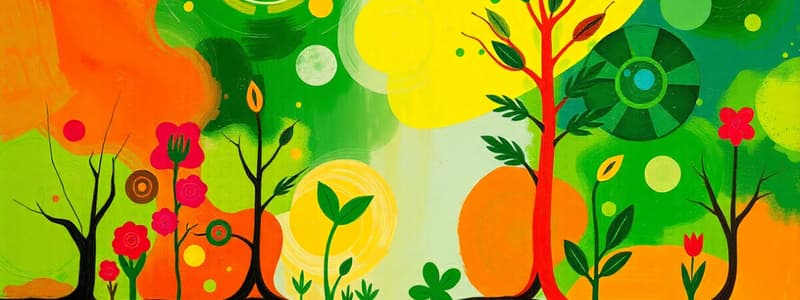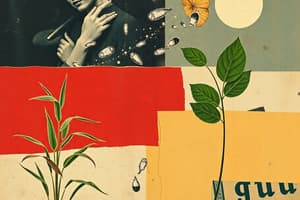Podcast
Questions and Answers
What do green plants use during photosynthesis to produce oxygen?
What do green plants use during photosynthesis to produce oxygen?
- Nitrogen
- Phosphorus
- Hydrogen
- Carbon dioxide (correct)
What color indicates a higher than normal level of carbon dioxide in the hydrogencarbonate indicator?
What color indicates a higher than normal level of carbon dioxide in the hydrogencarbonate indicator?
- Red
- Purple
- Green
- Yellow (correct)
In which condition do green leaves take in carbon dioxide?
In which condition do green leaves take in carbon dioxide?
- Under bright sunlight (correct)
- During respiration
- When wrapped in aluminium foil
- In the dark
Which of the following tubes served as a control setup in the experiment?
Which of the following tubes served as a control setup in the experiment?
What is the overall effect of green leaves on carbon dioxide levels in the presence of sunlight, as observed in tube A?
What is the overall effect of green leaves on carbon dioxide levels in the presence of sunlight, as observed in tube A?
What happens to the hydrogencarbonate indicator in tube C after five hours when the leaves are in the dark?
What happens to the hydrogencarbonate indicator in tube C after five hours when the leaves are in the dark?
Why is it important to ensure that leaves do not touch the hydrogencarbonate indicator in the experiment?
Why is it important to ensure that leaves do not touch the hydrogencarbonate indicator in the experiment?
What may be concluded about gas exchange in plants during the night based on the results from tube D?
What may be concluded about gas exchange in plants during the night based on the results from tube D?
What occurs in plants under light conditions regarding gas exchange?
What occurs in plants under light conditions regarding gas exchange?
What is the net gas exchange in plants during dark conditions?
What is the net gas exchange in plants during dark conditions?
What role do stomata play in plants?
What role do stomata play in plants?
What is true about the net carbon dioxide exchange during photosynthesis?
What is true about the net carbon dioxide exchange during photosynthesis?
When observing stomata under a microscope, which magnification is suggested for the initial observation?
When observing stomata under a microscope, which magnification is suggested for the initial observation?
Which of the following describes the gas exchange in plants by stomata?
Which of the following describes the gas exchange in plants by stomata?
What is a key point regarding gas exchange in plants?
What is a key point regarding gas exchange in plants?
Which statement correctly describes the relationship between photosynthesis and respiration under light conditions?
Which statement correctly describes the relationship between photosynthesis and respiration under light conditions?
Flashcards
Photosynthesis
Photosynthesis
The process by which green plants use sunlight to convert carbon dioxide and water into food (glucose) and oxygen.
Respiration
Respiration
The process by which plants use glucose (produced during photosynthesis) and oxygen to release energy.
Carbon Dioxide Uptake
Carbon Dioxide Uptake
Plants absorbing carbon dioxide from the atmosphere.
Oxygen Release
Oxygen Release
Signup and view all the flashcards
Hydrogencarbonate Indicator
Hydrogencarbonate Indicator
Signup and view all the flashcards
Control tubes (B and D)
Control tubes (B and D)
Signup and view all the flashcards
Gas exchange in leaves (light)
Gas exchange in leaves (light)
Signup and view all the flashcards
Gas exchange in leaves (dark)
Gas exchange in leaves (dark)
Signup and view all the flashcards
Net gas exchange
Net gas exchange
Signup and view all the flashcards
Photosynthesis
Photosynthesis
Signup and view all the flashcards
Respiration
Respiration
Signup and view all the flashcards
Stomata
Stomata
Signup and view all the flashcards
Light conditions (gas exchange)
Light conditions (gas exchange)
Signup and view all the flashcards
Dark conditions (gas exchange)
Dark conditions (gas exchange)
Signup and view all the flashcards
Leaf epidermis
Leaf epidermis
Signup and view all the flashcards
Microscope
Microscope
Signup and view all the flashcards
Study Notes
Gas Exchange in Plants
- Green plants carry out photosynthesis to create their own food.
- Photosynthesis uses carbon dioxide and produces oxygen.
- Respiration releases energy from food, using oxygen and producing carbon dioxide.
- Gas exchange is important throughout the day.
Practical 7.9 Study
- Aim: To determine how carbon dioxide levels change in tubes containing leaves, under light and dark conditions.
- Apparatus: Boiling tubes, cotton thread, fresh green leaves, test tube rack, measuring cylinder (10cm³), hydrogencarbonate indicator, table lamp, aluminium foil.
- Procedure:
- Add hydrogencarbonate indicator to tubes. Note the colour.
- Place leaves in some tubes (A & C).
- Seal tubes and avoid air leaks.
- Expose one set of tubes (A & C) to light, and the other set (B & D) to darkness.
- Observe the colour change after 5 hours
Hydrogencarbonate Indicator
- Different colors correspond to different carbon dioxide levels.
- Purple = lower than normal level
- Red = normal level (about 0.04%)
- Yellow = higher than normal level
Results and Discussion
-
- Tube A (light): The indicator colour changes to a vibrant purple, suggesting that the plant actively absorbed carbon dioxide from the surrounding environment as part of the process of photosynthesis. This change signifies the plant's ability to convert light energy into chemical energy, synthesizing glucose while releasing oxygen as a byproduct.
- Tube B (dark): In this tube, there is no noticeable change in the colour of the indicator, which remains red. This outcome indicates that the plant is not altering the levels of carbon dioxide present in its surroundings, likely due to the lack of light necessary for photosynthesis. The dark condition restricts the plant's ability to absorb carbon dioxide, thereby demonstrating the important role of light in the photosynthetic process.
- Tube C (light): Here, the indicator colour shifts to yellow, which reveals that the plant is releasing carbon dioxide as a result of respiration. This process typically occurs when plants convert glucose into energy for growth and metabolism, resulting in the production of carbon dioxide as a waste byproduct. It highlights the dual role of plants in both using and releasing carbon dioxide during different metabolic activities.
- Tube D (dark): In this instance, the indicator remains unchanged, retaining its red colour. This suggests that the plant does not alter the carbon dioxide levels, reinforcing the idea that, even in darkness, without the necessary light energy for photosynthesis, the plant cannot perform gas exchange efficiently. This showcases the metabolic limitations faced by plants during periods without light.
- The variations in colour changes across these tubes effectively illustrate the contrasting physiological responses of the plant to light and darkness. Such differences underscore the vital interplay between photosynthesis, which occurs in light, and respiration, which can occur both in light and dark conditions. Consequently, these observations help us understand the intricate balance of gas exchange in plants and how it affects the carbon dioxide concentration in the environment.
Gas Exchange in Plants Under Light Conditions
-
Plants carry out both photosynthesis and respiration..
-
The rate of photosynthesis is usually greater than respiration.
-
This leads to a net uptake of carbon dioxide and release of oxygen.
Gas Exchange in Plants Under Dark Conditions
- Plants only carry out respiration, not photosynthesis
- This results in a net release of carbon dioxide and uptake of oxygen.
Gas Exchange Through Stomata
- Gases like carbon dioxide and oxygen are exchanged through pores called stomata.
- These pores are located on leaves.
Studying That Suits You
Use AI to generate personalized quizzes and flashcards to suit your learning preferences.




